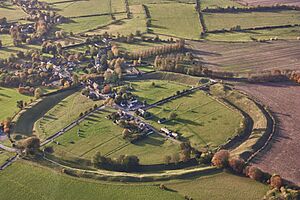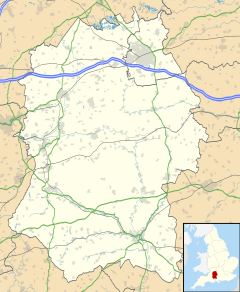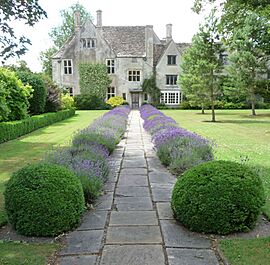Avebury (village) facts for kids
Quick facts for kids Avebury |
|
|---|---|
 Avebury from the air |
|
| Population | 582 (in 2021) |
| OS grid reference | SU101699 |
| Civil parish |
|
| Unitary authority |
|
| Ceremonial county | |
| Region | |
| Country | England |
| Sovereign state | United Kingdom |
| Post town | Marlborough |
| Postcode district | SN8 |
| Dialling code | 01672 |
| Police | Wiltshire |
| Fire | Wiltshire |
| Ambulance | Great Western |
| EU Parliament | South West England |
| UK Parliament |
|
Avebury is a village and civil parish in Wiltshire, England. It's located about 5.5 kilometres (3.4 miles) west of Marlborough and 8 kilometres (5 miles) northeast of Devizes. A large part of the village is surrounded by a very old stone monument, which is also called Avebury. The area also includes the small villages of Avebury Trusloe and Beckhampton, along with the tiny settlement of West Kennett.
Contents
Ancient History
Stone Circles
The Avebury monument is huge! It's made up of several smaller sites built at different times. The oldest parts are the earthworks, which are big banks and ditches created between 3400 and 2625 BC. Later, a henge (a circular earthwork) and several stone circles were added.
Starting around the 1300s, local people began to take apart the stone circles. They did this for different reasons: to clear land for farming, to use the stones for building, or because they saw them as old pagan (non-Christian) symbols.
In 1648, a man named John Aubrey visited the site. He found most of the huge stones still standing or lying nearby. He wrote:
These Downes looke as if they were Sown with great Stones, very thicke; and in a dusky evening they looke like a flock of Sheep: from whence it takes its name. One might fancy it to have been the Scene where the Giants fought with stones against the Gods... I was wonderfully surprised at the sight of those vast stones, of which I had never heard before; as also at the mighty Banke and Graffe [ditch] about it. I observed in the Inclosures some segments of rude circles, made with these stones, whence I concluded, they had been in old time complete.
Later, in the 1700s, William Stukeley visited and wrote about even more damage that had happened. In 1872, a banker and politician named Sir John Lubbock bought part of the village to protect the monuments. He also helped create the Ancient Monuments Protection Act 1882, which made the British government protect ancient sites.
In the 1930s, an archaeologist named Alexander Keiller put many of the fallen stones back up. This helped to restore the circle to how it might have looked long ago. In 1943, the government took over the monument and village. Today, they are looked after by the National Trust. In 1986, UNESCO added Avebury, along with Stonehenge, Silbury Hill, and other nearby sites, to its World Heritage List. This means they are very important places for everyone in the world.
Modern History
A Roman road from Silchester to Bath once passed through this area. It followed the Kennet valley west from Cunetio (near Marlborough) and then went over West Down. You can still see a part of the road's raised path, called an agger, southwest of Beckhampton. It's about 300 metres (yards) long and up to 1 metre (3 feet) high.
The Domesday Book from 1086 mentioned a church at Avreberie. The village grew around this church and the manor houses of Avebury and Avebury Trusloe. By 1377, Avebury was one of the largest settlements in its area, with 134 people paying a special tax.
Over the centuries, the land and manor houses in Avebury changed hands many times. Important owners included Sir William Sharington in the 1500s and later Baron Stawell. In 1943, the National Trust bought Manor Farm. The main house, Avebury Manor, was bought by Sir Francis Knowles in 1955. He restored it and opened it to the public. The National Trust bought the manor house itself in 1991.
Avebury Trusloe
Another important estate, Avebury Trusloe, was bought by Joan Trusloe in 1563. Later, Alexander Keiller (the archaeologist who restored the stone circles) bought a farm here in the 1920s. He sold it to the National Trust in 1943.
Beckhampton
Racehorses have been trained at Beckhampton House since the mid-1800s. Many famous trainers have worked here, including Sam Darling and his son Fred Darling, who together trained nine Derby winners in the early 1900s.
Geography
The River Kennet flows south through the Avebury area. It passes west of Avebury village before turning east near Silbury Hill on its way to Marlborough. Higher areas include Windmill Hill in the northwest and Avebury Down in the east.
The villages of Beckhampton, Avebury Trusloe, and Avebury are all on the A4361 road. The A4 road, which connects Calne and Marlborough, crosses the A4361 at Beckhampton and continues east through West Kennet.
Religious Sites
Parish Church
The Church of England parish church of St James is very interesting for its history. There was a stone church here, just west of the ancient earthwork, as early as the 900s. Parts of this very old building still exist, like some corner stones and two small windows at the west end. These windows once had shutters instead of glass! Three round windows in the north wall are also from the Anglo-Saxon period.
More parts were added in the 1100s, and the church was made wider in the 1400s. The three-stage west tower was also built around this time. The church was repaired in the 1800s. In 1966, it was given a Grade I listed status, meaning it's a very important historic building.
The stone font (where baptisms happen) has carvings that might be from two different times. The lower part has arches, while the upper part shows plants, two snakes or dragons, and a figure that might be Saint Michael.
The screen in front of the chancel (the area near the altar) was designed in 1884. Above it is a special rood loft from the 1400s. This loft has colorful panels and is quite rare because it's still complete. It was hidden behind a wall after the Reformation in the 1500s and wasn't found again until 1810.
The church tower has eight bells. The oldest one, cast in 1719, now strikes the hours.
Chapels
A nonconformist chapel was built inside the stone circle around 1670. It was later made bigger. In the 1900s, the church group joined the United Reformed Church. The building is now an information center for visitors, as regular services stopped by 2015.
A Strict Baptist chapel was built in 1873, but it closed around 1953.
Notable Buildings
Avebury parish has three Grade I listed buildings: St James' church, Avebury Manor, and the Great Barn at Manor Farm. The Great Barn was built in the late 1600s and has a thatched roof. It was restored in 1978 and is now used as a museum by the National Trust.
Beckhampton House started as a large inn for travelers around 1745. Since 1855, it has been the farmhouse for the racehorse stables. A nearby 1600s house is now the Waggon and Horses pub.
West Kennett House was built around 1800. It's a three-story brick house with a columned porch.
Avebury Manor
Avebury Manor and Garden is a property owned by the National Trust in the village, close to the church. It includes the manor house and its garden. The house was started around 1557 and has been changed and rebuilt over the years. It is also a Grade I listed building. Since 1938, its old stables from the 1700s have been home to a museum, which is now called the Alexander Keiller Museum. There's also a well-preserved circular dovecote from the 1500s on the grounds.
How Avebury is Governed
Avebury is a civil parish with its own elected parish council. This council helps with local matters. The larger area is managed by Wiltshire Council, which is a unitary authority. This means it handles most of the important local government tasks. For national elections, Avebury is part of the East Wiltshire area.
Things to Do and See
The village pub, The Red Lion, used to be a farmhouse from the late 1500s. It claims to be the only pub in the world surrounded by a stone circle! It was built over the village's 86-foot deep well. This well is now covered with glass and used as a dining table. Another pub, the Waggon and Horses, is about one mile southwest of the village in Beckhampton. The National Trust also has a restaurant for visitors in some old farm buildings.
Avebury village doesn't have a school anymore. The primary school closed in 2007. The old school building, on the High Street, is now a social club for the community.






